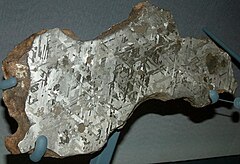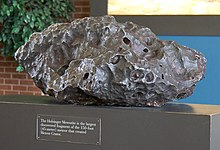

| Canyon Diablo | |
|---|---|

Canyon Diablo iron meteorite fragment (IAB) 2,641 grams
| |
| Type | Iron |
| Structural classification | Coarse Octahedrite |
| Group | IAB-MG |
| Composition | 7.1% Ni; 0.46% Co; 0.26% P; 1% C; 1% S; 80ppm Ga; 320ppm Ge; 1,9ppm Ir |
| Country | United States |
| Region | Coconino County, Arizona |
| Coordinates | 35°03′N 111°02′W / 35.050°N 111.033°W / 35.050; -111.033[1] |
| Observed fall | No |
| Fall date | 49000 years ago[2] |
| Found date | 1891 |
| TKW | 30tonnes |
| Strewn field | Yes |
 Etched slice showing a Widmanstätten pattern | |
The Canyon Diablo meteorite refers to the many fragments of the asteroid that created Meteor Crater (also called Barringer Crater),[3] Arizona, United States. Meteorites have been found around the crater rim, and are named for nearby Canyon Diablo, which lies about three to four miles west of the crater.
The impactor fell about 50,000 years ago.[4] Initially known and used by pre-historic Native Americans, Canyon Diablo meteorites have been collected and studied by the scientific community since the 19th century. Meteor Crater, from the late 19th to the early 20th century, was the center of a long dispute over the origin of craters that showed little evidence of volcanism. That debate was largely settled by the early 1930s, thanks to work by Daniel M. Barringer, F.R. Moulton, and Harvey Harlow Nininger.[5][6][7][8][9][10][11]
In 1953, Clair Cameron Patterson measured ratios of the lead isotopes in samples of the meteorite. Through U-Pb radiometric dating, a refined estimate of the age of the Earth was obtained: 4.550 billion years (± 70 million years).[12]
This meteorite is an iron octahedrite (coarse octahedrite). Minerals reported from the meteorite include:
Samples may contain troilite-graphite nodules with metal veins and small diamonds.


The biggest fragment ever found is the Holsinger Meteorite, weighing 639 kilograms (1,409 lb), now on display in the Meteor Crater Visitor Center on the rim of the crater. Other famous fragments:
{{cite web}}: CS1 maint: bot: original URL status unknown (link)
|
| |||||||||||||||||||||||
|---|---|---|---|---|---|---|---|---|---|---|---|---|---|---|---|---|---|---|---|---|---|---|---|
| Meteorite... |
| ||||||||||||||||||||||
| Classification |
| ||||||||||||||||||||||
| Mineralogy and petrology |
| ||||||||||||||||||||||
| Lists |
| ||||||||||||||||||||||
| |||||||||||||||||||||||
|
Meteorites by name
| |
|---|---|
| A–B |
|
| C–D |
|
| E–F |
|
| G–H |
|
| I–J |
|
| K–L |
|
| M–N |
|
| O–P |
|
| Q–R |
|
| S–T |
|
| U–V |
|
| W–X |
|
| Y–Z |
|
| |